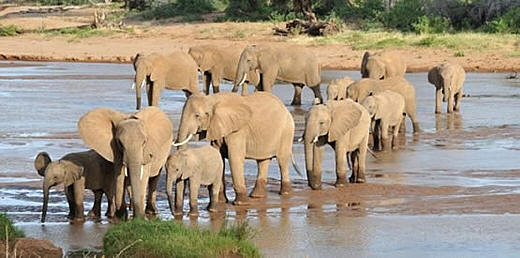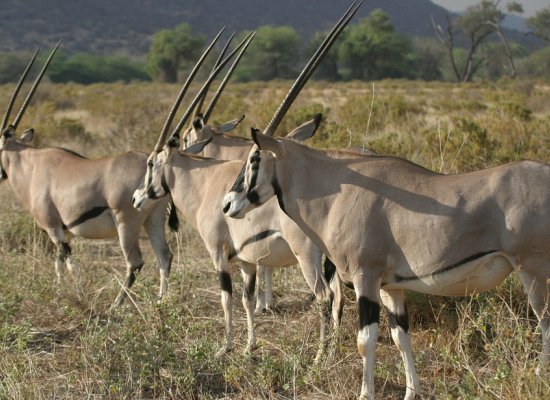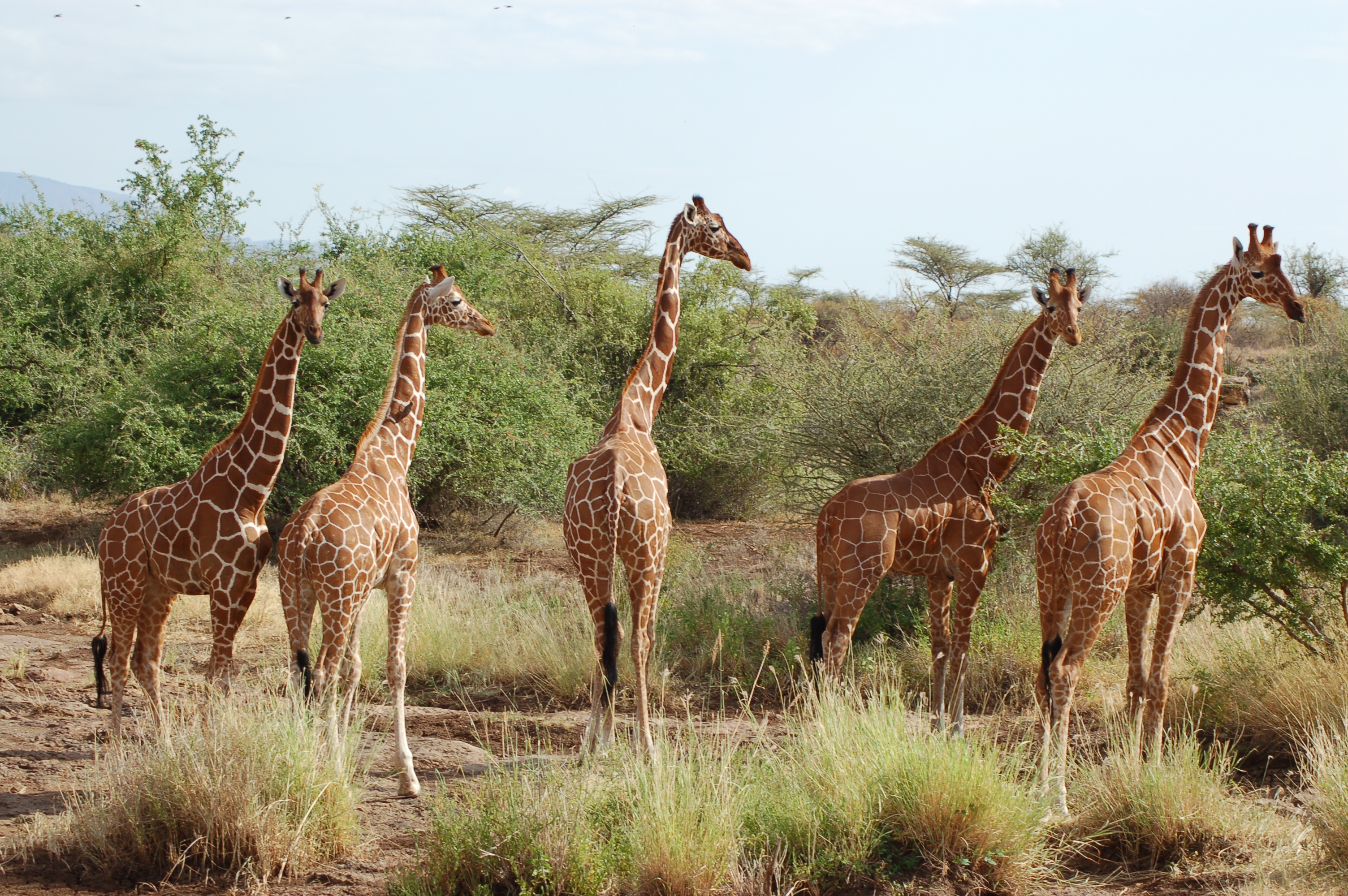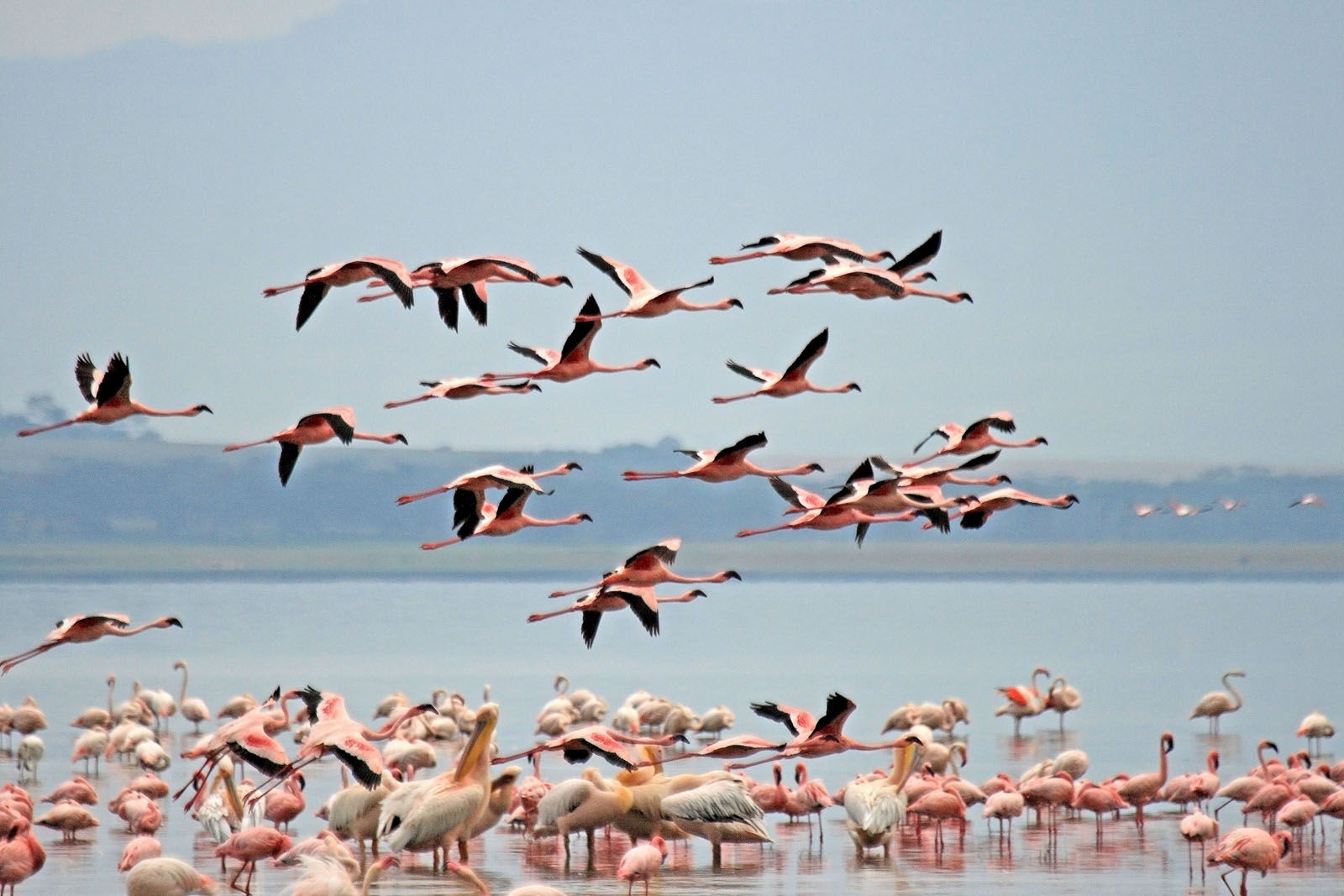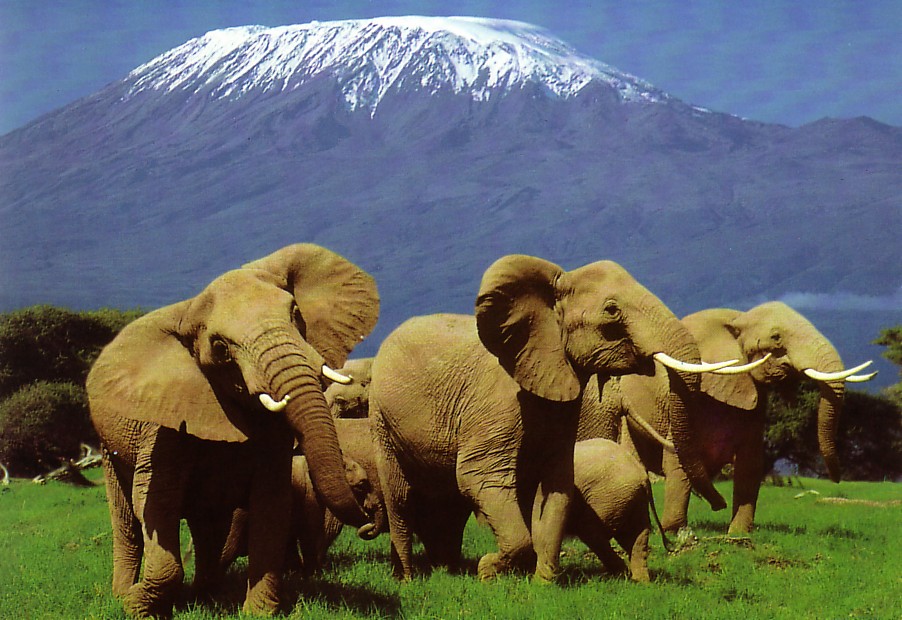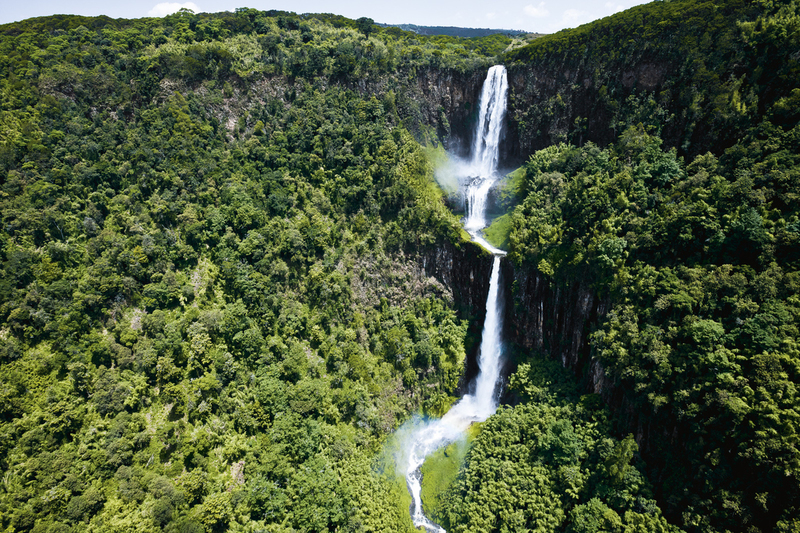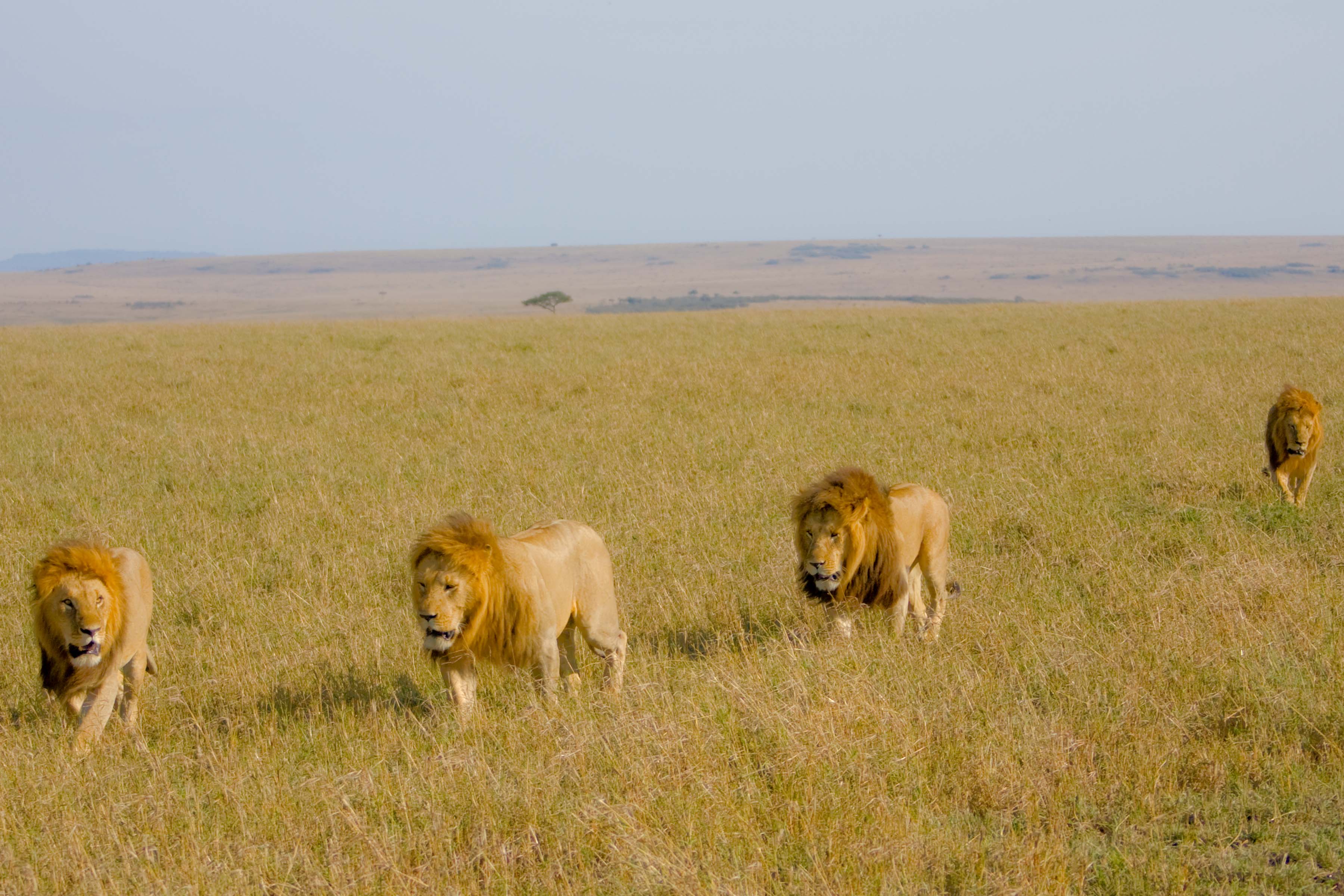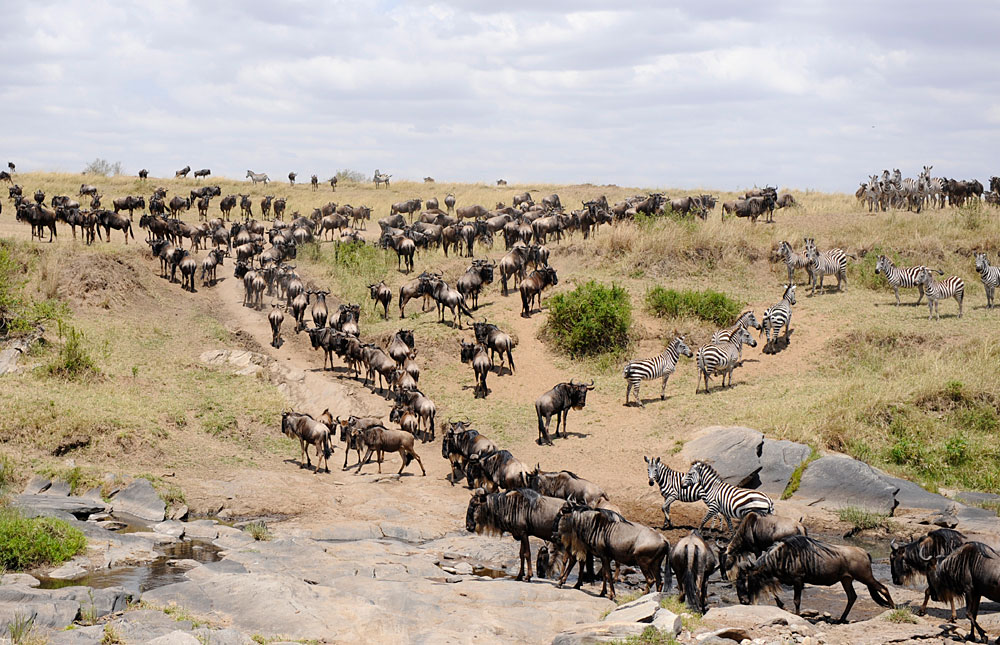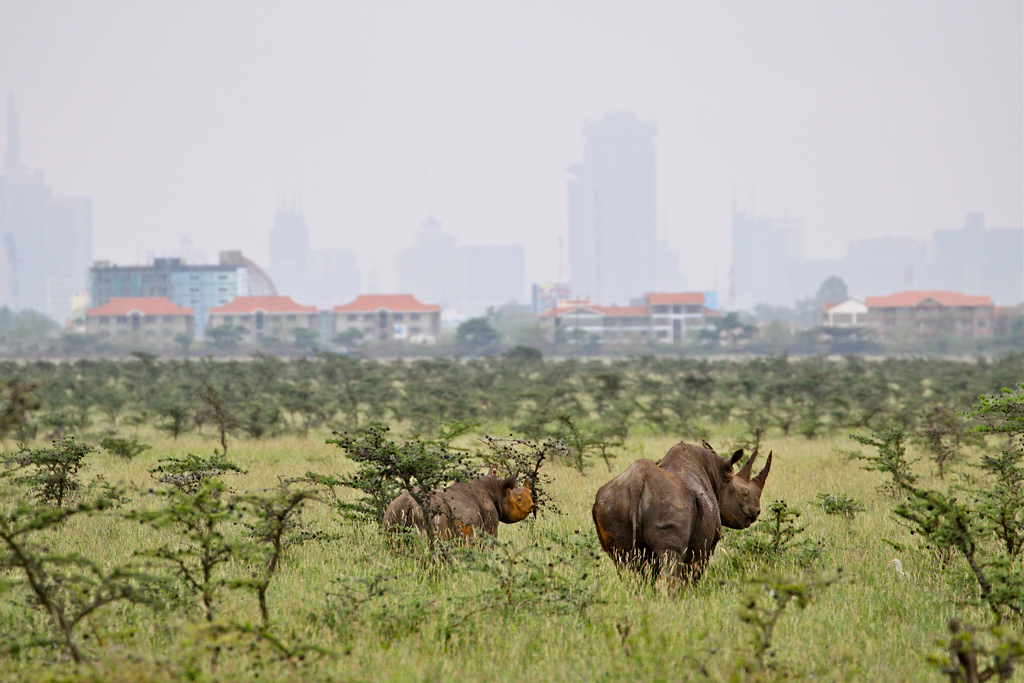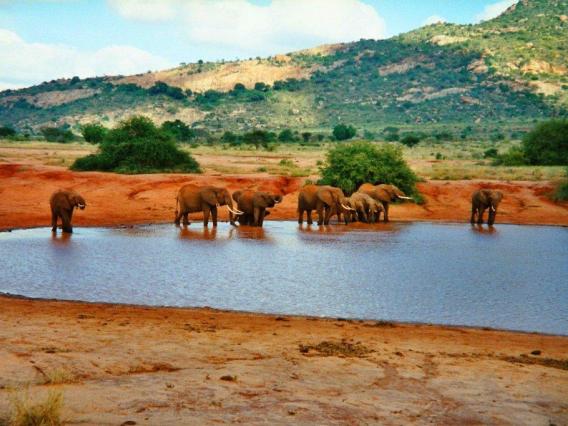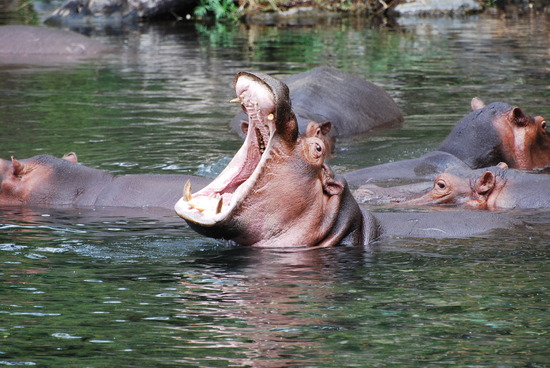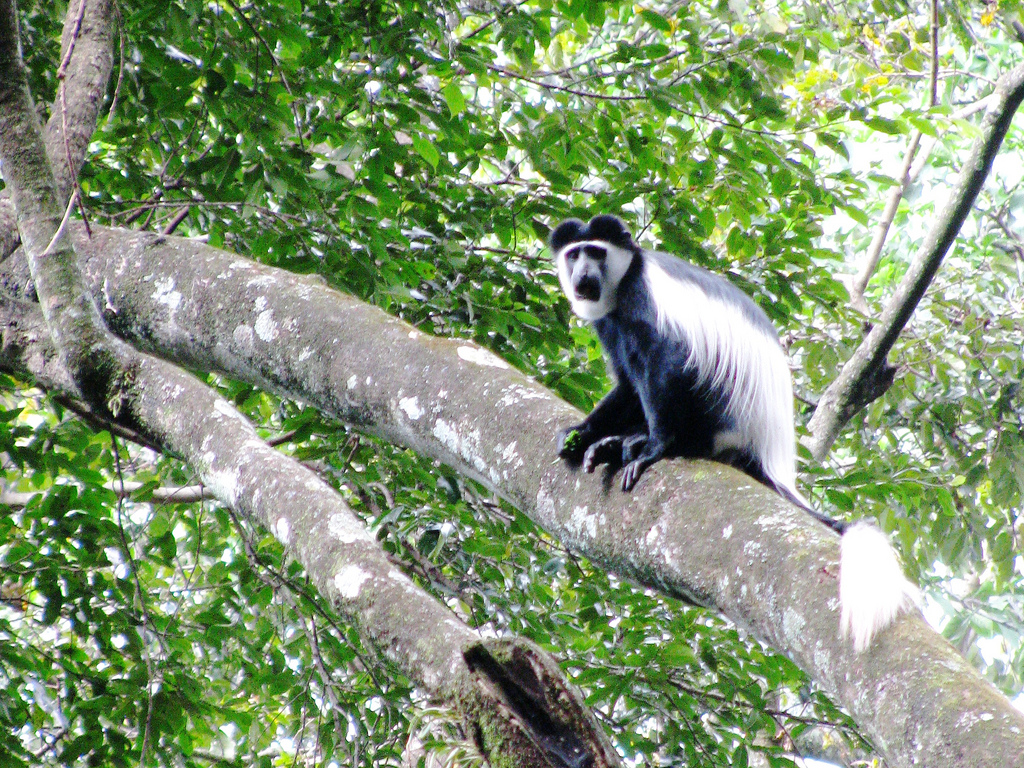We offer a wide range of Safari packages in the Best Wildlife Parks and Reserves in Kenya.
Samburu, Shaba & Buffalo Springs Game Reserves
Samburu Game Reserve lies in the Northern part of Kenya. It is one of the 56 protected areas in Kenya. It is famous North of the equator because of the richness of flora and fauna. It rises to an altitude of 2785 ft above sea level and covers an area of 390 km2. The Game Reserve was established in 1948 as part of the enormous Marsabit National Reserve under the national park ordinance. In 1962 with the financial help from Elsa Trust, Samburu Game Reserve was formed. In January 1963 the Minister for Local Government recommended Samburu National Reserve to be administered by the African District Council of Samburu.
Shaba Game Reserve is to the east of the Samburu and Buffalo Springs national reserves. Together, the three reserves form a large protected area. The Shaba reserve has dramatic scenery including river-side forests, scattered woodlands and dry grasslands dominated by the Shaba Hill volcano. The plentiful wildlife relies on waterholes and marshes scattered throughout the reserve. Shaba is home to the endangered Grevy’s zebra and the rare Williams’s lark. Shaba was the setting for the book and film Born Free, for the film Out of Africa and for the reality show Survivor: Africa.
The Buffalo Springs National Reserve is south of the Samburu National Reserve and on of the Best Game Parks and Reserves in Kenya. It is named after an oasis of clear water at its western end. The reserve has an area of 131 square kilometres (51 sq mi), and is at an altitude of between 850 metres (2,790 ft) and 1,230 metres (4,040 ft) above sea level. It is a gently rolling lowland plain of old lava flows and volcanic soils of olivine basalt. The main feature is the Champagne Ride in the southeast, an ancient lava-terrace. The climate is hot, dry and semi-arid. The reserve was established in 1948 as part of the Samburu – Isiolo Game Reserve, and the present boundaries were established in 1985. The reserve is managed by the Isiolo County Council.
The neighbouring communities to the three reserves are the Samburu tribe a sub-clan of the Maa-speaking people which include the Ilchamus (Njemps) and the Masai. They play a major role as part of tourist attraction in the area due to their unique cultural believes and practices traditional ceremonies, food, dances and sale of traditional crafts.
The climate is hot dry with cool nights with an average annual maximum temperature of 30ºc (86F) and minimum annual temperature of 20ºc (68F). Samburu Game Reserve receives 350mm (14 inches) during peak rainfall in April and November (Variable). Long rains are expected in early April to the end of May and short rains from mid-October to mid-December. Dry conditions usually prevail from June to early October and from January to March.
Botanists have identified more than 2 dozen plants communities, but thorny scrubs cover much of the reserve – the most common are Acacia elator, Acacia tortolise, Salvadora pesica and the Down palms.
There are over 50 species of wild animals in the reserve including unique species of Gravy Zebra, Reticulated Giraffe, Besia Oryx, Greater and Lesser Kudu, Gerenuk, Somali ostrich, pancake tortoise and others. There are over 450 species of birds identified and aquatic species in the Waso Nyiro River.
Lake Nakuru National Park – Best Game Parks and Reserves in Kenya
Lake Nakuru National Park, whose total area is 188 km2, was created in 1961. Nakuru means “Dust or Dusty Place” in the Maasai language. The park is best known for its thousands, sometimes millions of flamingos nesting along the shores. The lake’s abundance of algae attracts the vast quantity of flamingos. Other birds also flourish in the area, as do warthogs, baboons and other large mammals. Eastern black rhinos and southern white rhinos have also been introduced.
The lake’s level dropped dramatically in the early 1990s but has since largely recovered. In 2013, the lake received an alarming increase in the water levels that led to the migration of flamingos to Lake Bogoria in search for food supply.
The park is a sanctuary for the black rhino with more than 25 eastern black rhinoceros, one of the largest concentrations in the country, plus around 70 endemic southern white rhinos. There are also a number of Rothschild’s giraffes, Waterbucks, lion, cheetah and African leopard, balloons among many others. Bird species that inhabit the lake and the area surrounding include the African fish eagle, Goliath heron, hamerkop, pied kingfisher and Verreaux’s eagle.
Amboseli National Park
Amboseli National Park is 39,206 hectares (392 km2; 151 sq mi). The local people are mainly Maasai, but people from other parts of the country have settled there attracted by the successful tourist-driven economy and intensive agriculture along the system of swamps that makes this low-rainfall area (average 350 mm (14 in)) one of the best wildlife-viewing experiences in the world with 400 species of birds including water birds, pelicans, kingfishers, crakes, hammerkops and 47 types of raptors.
The park protects two of the five main swamps, and includes a dried-up Pleistocene lake and semi-arid vegetation. The park is 240 kilometres (150 miles) southeast from Nairobi. Amboseli National Park is the second most popular national park in Kenya after Masai Mara National Reserve.
Amboseli was gazetted as a National Park in 1974 to protect the core of this unique ecosystem. it was declared a UNESCO Man and the Biosphere Reserve in 1991.
The park is famous for being the best place in Africa to get close to free-ranging elephants. Other attractions include a visit a Masai village. The park also offers spectacular views of Mount Kilimanjaro, the highest free-standing mountain in the world.
Amboseli National Park is home to many species, including the African elephant, cape buffalo, impala, lion, cheetah, spotted hyena, giraffe, zebra and wildebeest among other African animals. There is also a host of Kenyan birds, both large and small, to see if you keep your eyes open and stop at every sighting.
Aberdare National Park
The Aberdare National Park is located about 100 km north from Nairobi. It was established in May 1950 and covers an area of 766 square kilometres. The park contains a wide range of landscapes – from the mountain peaks that rise to 14,000 feet (4,300 m) above sea level, to their deep, v-shaped valleys intersected by streams, rivers, and waterfalls. Moorland, bamboo forests and rainforests are found at lower altitudes.
Animals here include the leopard, African elephant, African hunting dog, giant forest hog, bushbuck, mountain reedbuck, waterbuck, Cape buffalo, suni antelope, side-striped jackal, eland, duikers olive baboon, black and white colobus monkey, and sykes monkey. Rarer sightings include the golden cat and the bongo – an elusive forest antelope that lives in the bamboo forest. The Aberdare National Park also contains a large population of the black rhino.
Visitors to the park can find different types of accommodation according to their taste, ranging from the Treetops tree-house lodge, to the Ark – built in the shape of Noah’s Ark – and three self-help banda sites, eight special campsites and a public campsite in the moorland.. Both Treetops and Ark provide excellent night-time wildlife viewing. From here, visitors can observe various animals, such as elephant, buffalo, lion and rhino, which get attracted to the waterholes. The park also includes two airstrips at Mweiga and Nyeri.
The Masai Mara Game Reserve
The Masai Mara game reserve is named in honour of the Masai people (the ancestral inhabitants of the area). “Mara,” in Masai language means “spotted,” an apt description for the circles of trees, scrub, savannah, and cloud shadows that mark the area.
The Maasai Mara National Reserve covers some 1,510 km2 (583 sq mi) in south-western Kenya. It is the northern-most section of the Mara-Serengeti ecosystem, which covers some 25,000 km2 (9,700 sq mi) in Tanzania and Kenya. It is bounded by the Serengeti Park to the south, the Siria escarpment to the west, and Masai pastoral ranches to the north, east and west.
The Masai Mara game reserve is globally famous for its exceptional population of Masai lions, African leopards and Tanzanian cheetahs, and the annual migration of zebra, Thomson’s gazelle, and wildebeest to and from the Serengeti every year from July to October, known as the Great Migration.
The Maasai Mara National Reserve is only a fraction of the Greater Mara Ecosystem, which includes several Group Ranches: Koiyaki, Lemek, Ol Chorro Oirowua, Olkinyei, Siana, Maji Moto, Naikara, Ol Derkesi, Kerinkani, Oloirien, and Kimintet.
Lewa Wildlife Conservancy
The Lewa Wildlife Conservancy (also known as Lewa Downs) was formed in 1995 and is located in northern Kenya. It is a wildlife sanctuary incorporating the Ngare Ndare Forest and covering over 62,000 acres (250 km2). It is home to a wide variety of wildlife including the rare and endangered black rhino, Grevy’s zebra and Sitatunga antelope, lion, African leopard, bush elephant, rhino and African buffalo. Lewa holds over 12% of Kenya’s eastern black rhinoceros population and the largest single population of Grevy’s zebras in the world (approximately 350 individuals).
The Lewa Marathon is held in the Lewa Conservancy each year for fundraising purposes – the funds are channelled into wildlife conservation.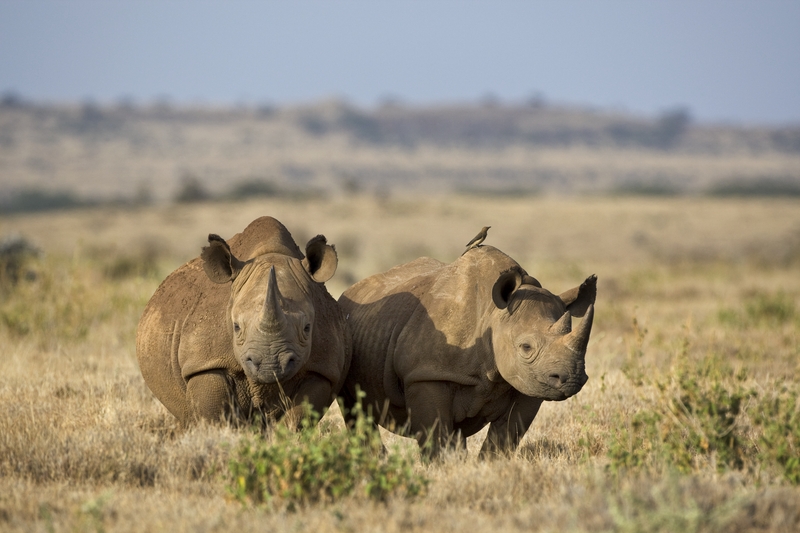
Nairobi National Park
Nairobi National Park was established in 1946, and was Kenya’s first. It is located approximately 7 kilometres (4 mi) south of the centre of Nairobi, Kenya’s capital city, with an electric fence separating the park’s wildlife from the metropolis.
The park covers an area of 117.21 square kilometres (28,963 acres). Its predominant environment is open grass plain with scattered Acacia bushes. The park has a large and diverse wildlife population including African buffalo, baboon, Eastern black rhinoceros, Grant’s zebra, Tanzanian cheetah, Coke’s hartebeest, Grant’s gazelle, hippopotamus, African leopard, Masai lion, Thomson’s gazelle, eland, impala, Masai giraffe, ostrich, vulture, Jackal, Warthog, Kongonies, Maribu Stalks and waterbuck.
Tsavo East National Park
Tsavo East National Park is one of the oldest and largest parks in Kenya and covers 13,747 square kilometres. Situated in a semi-arid area previously known as the Taru Desert; it opened in April 1948. The park was named after the Tsavo River, which flows west to east through the national park. It borders the Chyulu Hills National Park, and the Mkomazi Game Reserve in Tanzania.
The Tsavo East National Park is generally flat, with dry plains across which the Galana River flows. Other features include the Yatta Plateau and Lugard Falls.
Major attractions include the Mudanda Rock, the Yatta Plateau, Lugard Falls and the Aruba Dam. Wildlife here include a population of lions, were adult males often lack manes entirely, aardwolf, yellow baboon, bat, cape buffalo, bushbaby, bushbuck, caracal, African wildcat, Tanzanian cheetah, African Civet, dik-dik, African hunting dog, African dormouse, Blue Duiker, bush duiker, Red duiker, eland, African elephant, bat-eared fox, greater galago, gazelle, large-spotted Genet, small-spotted genet, gerenuk, giraffe, African hare, springhare, Coke’s hartebeest, hunter hartebeest, East African hedgehog, spotted hyena, striped hyena, rock hyrax, tree hyrax, impala, black-backed jackal, side-striped jackal, klipspringer, Lesser Kudu, leopard, lion, banded mongoose, dwarf mongoose, Egyptian Mongoose, Marsh Mongoose, slender mongoose, White-tailed Mongoose, black faced vervet monkey, Sykes’ monkey, fringe-eared oryx, clawless otter, ground pangolin, crested porcupine, cane rat, giant rat, naked mole rat, ratel, bohor reedbuck, black rhinoceros, serval, spectacled elephant shrew, bush squirrel, East African red squirrel, striped ground squirrel, Unstriped Ground Squirrel, suni, warthog, waterbuck, common zebra and Grevy’s zebra.
Over 500 bird species have been recorded in the area, including ostriches, kestrels, buzzards, starlings, weaver birds, kingfishers, hornbills, secretary birds and herons.
Tsavo West National Park
Tsavo West National Park covers an area of 9,065 square kilometres. It adjoins the Tsavo East National Park. There is evidence for thriving Late Stone Age economy from 6,000 to 1,300 years ago. Research has shown that Late Stone Age archaeological sites are found close to the Galana River in high numbers. The inhabitants of these sites hunted wild animals, fished and kept domesticated animals.
Tsavo West National Park has a variety of wildlife, such as eastern black rhino, cape buffalo, African bush elephant, African leopard and Masai lion. There are also other smaller animals that can be spotted in the park, such as the bushbaby, hippo, hartebeest, lesser kudu and Masai giraffe.
Another major attraction is the Mzima Springs; a series of four natural springs in Tsavo West National Park. The source of the springs is a natural reservoir under the Chyulu Hills to the north. Mzima’s famously clear stream flows through a series of pools and rapids. Two kilometres downstream from the springs, the stream is blocked by a solidified lava flow and disappears below the surface again. Mzima is one of Tsavo’s most popular wildlife attractions owing to its resident populations of hippos and Nile crocodiles. Mzima Springs supplies 90 million litres per day to Voi, Mariakani, and the South Coast.
Kakamega Forest
Kakamega Forest is a tropical rainforest situated in the Kakamega and Kisumu Counties of Kenya, North West of the capital Nairobi. It is Kenya’s only tropical rainforest and is said to be Kenya’s last remnant of the ancient Guineo-Congolian rainforest that once spanned the continent.
The forest including reserves encloses about 238 square kilometers, a little less than half of which currently remains as indigenous forest. Kakamega National Reserve was given national forest reserve status in 1985.
The Kakamega Forest is very wet, with an average of 1200 mm – 1700 mm of rain per year. Rainfall is heaviest in April and May (“long rains”), with a slightly drier June and a second peak roughly in August to September (“short rains”). January and February are the driest months. Temperature is fairly constant throughout the year, ranging between 20c – 30c.
Flora found in the park include some of Africa’s greatest hard and soft woods: Elgon teak, red and white stinkwood and several varieties of croton and aniageria altisima. There are 380 recorded species of plants. This includes 60 species of ferns, 150 species of trees and shrubs, and 170 species of flowering plants including 60 species of orchids with 9 species found only in this forest.
The forest is famous for its birds, over 350 bird species have been recorded in the forest such as the west African Great blue turaco and black-and-white-casqued hornbill. At least 9 birds are not found anywhere else.
Wildlife that occur in the park include bush pig, duikers, bushbuck, African clawless otter, mongoose, giant African water shrew, squirrels, tree pangolin, porcupine, bats and a variety of primates including the blue monkey, redtail monkey, De Brazza’s monkey, baboon, potto and the occasional vervet monkey.
Insects are abundant and some are quite spectacular, such as Goliath beetles, pink and green flower mantis, and numerous colorful butterflies (489 species). Particularly well represented groups are ants (Formicidae), Lepidopterans, Orthopterans, and beetles. Gastropods, millipedes and spiders are also common.
We hope this post helped you find the Best Wildlife Parks and Reserves in Kenya.
See Also: 12 Days Kenya & Tanzania Wildebeest Migration Safari

